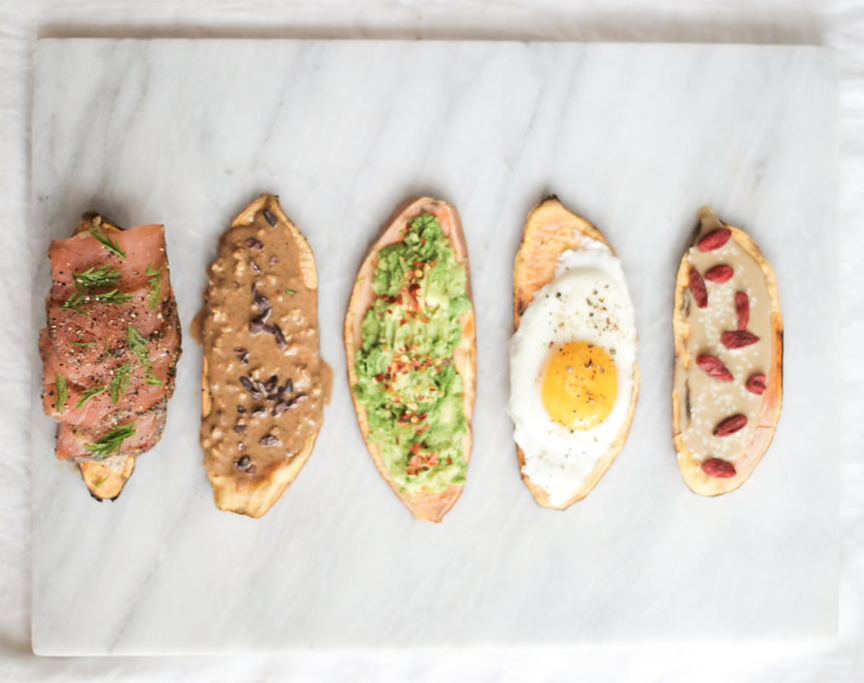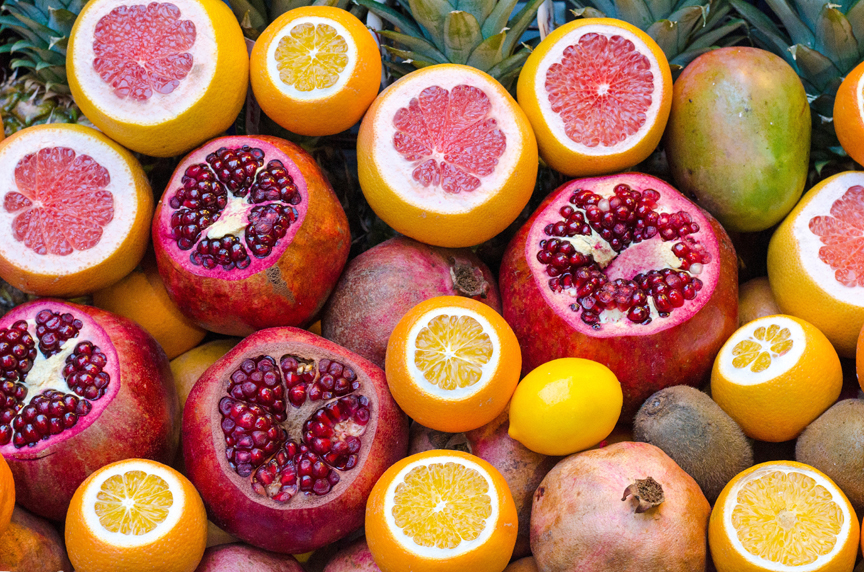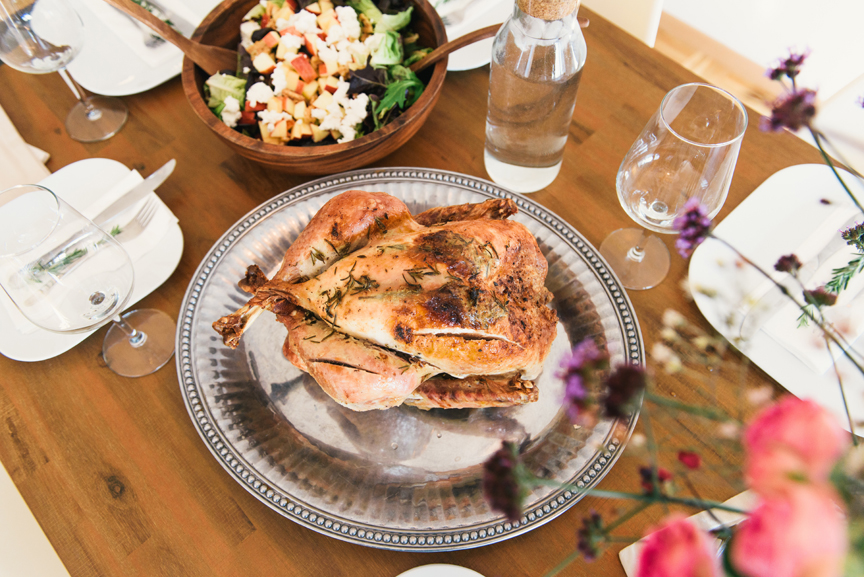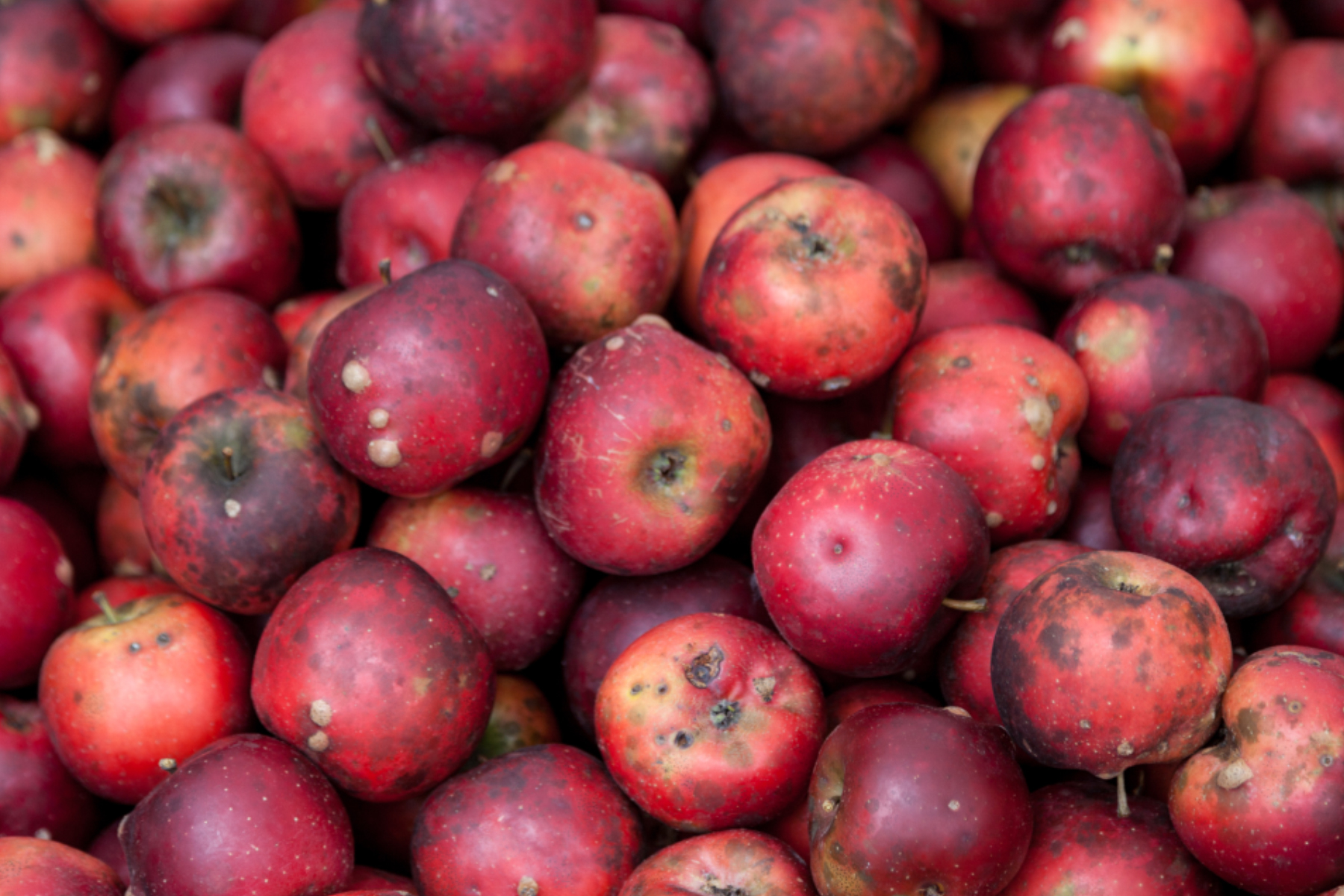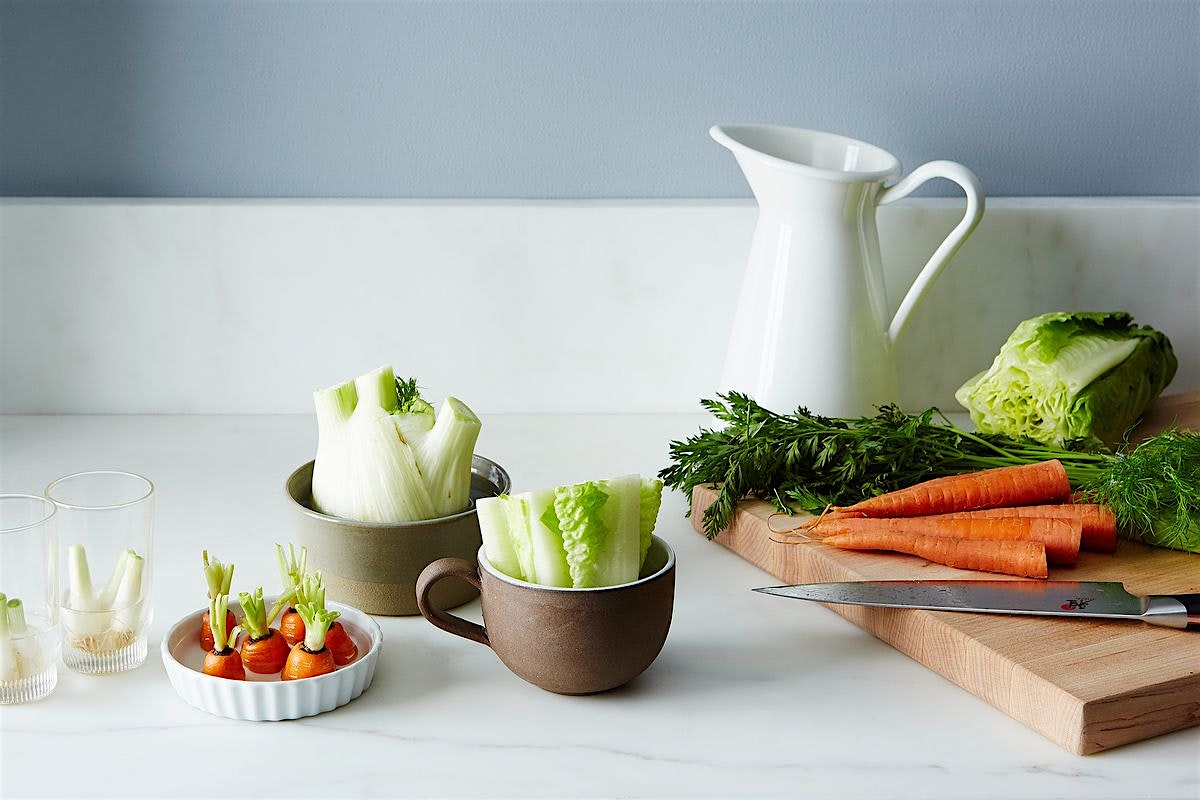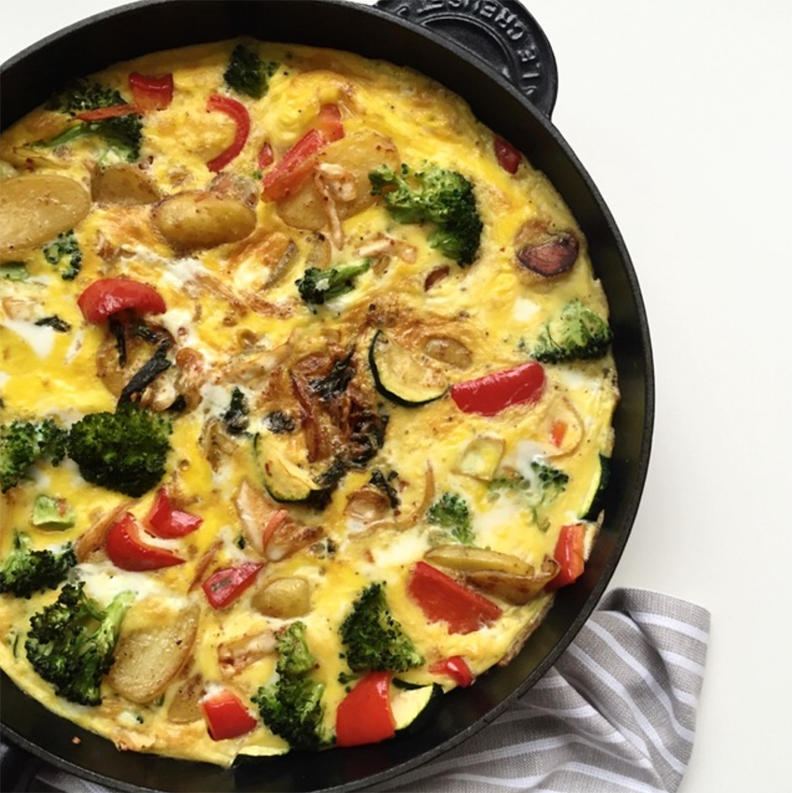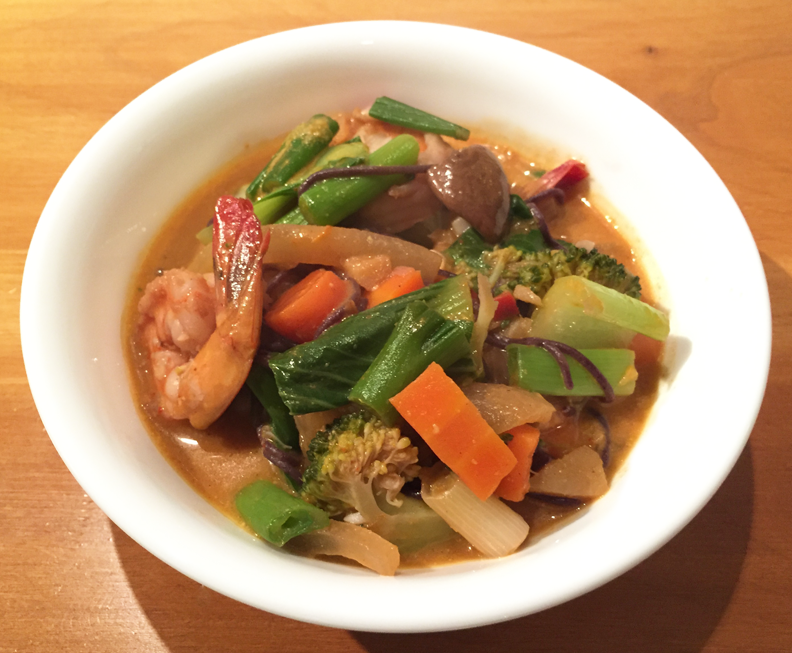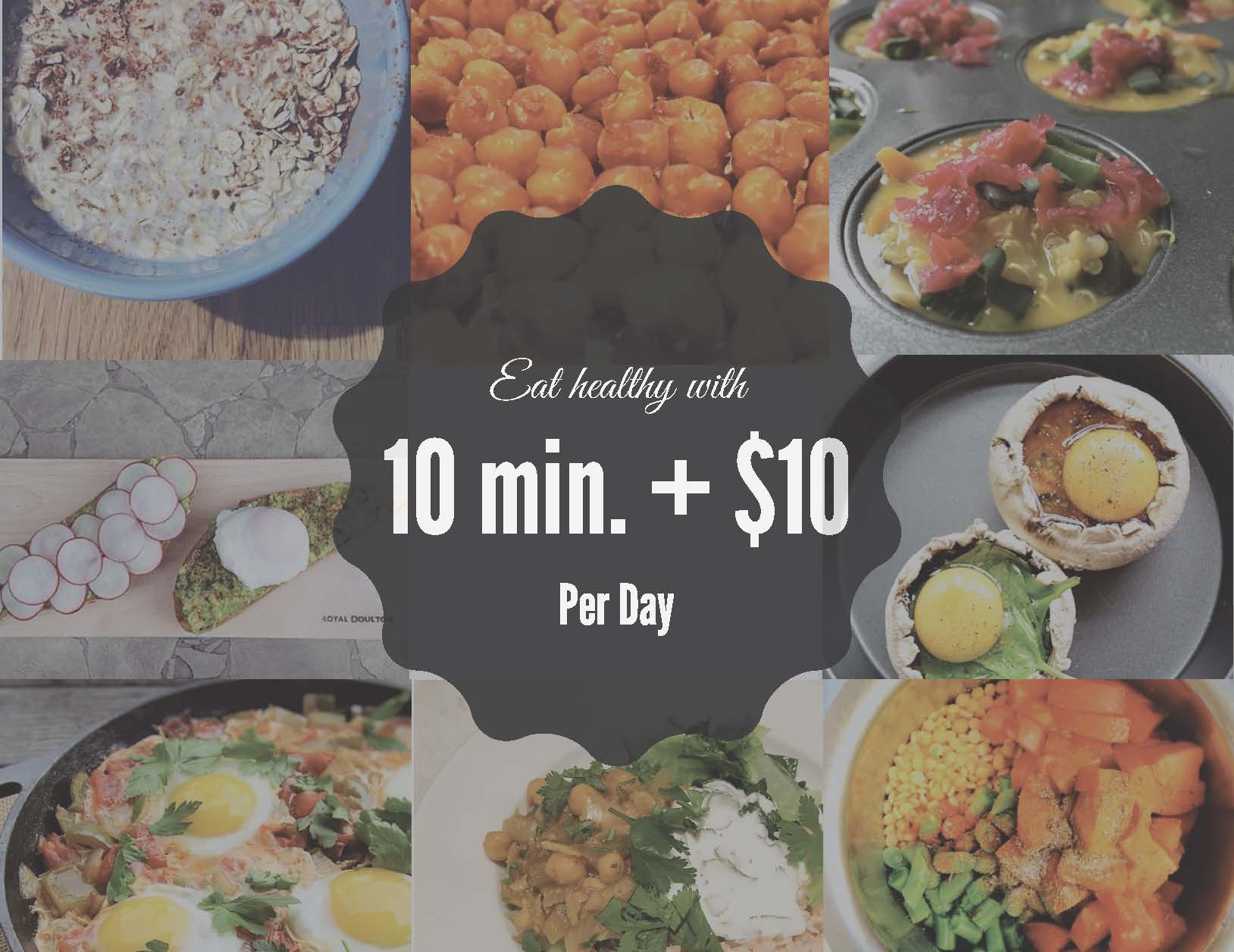
You know you need to eat more healthfully, but doing so when you’re short on time and on a budget is NOT easy. Which is why we’ve come up with delicious and nutritious, easy-to-execute, minimally-processed, affordable meals so you can ditch the frozen dinners and cheap, bad-for-you snacks. With a little Sunday night prep, each of these meals can be made with less than 10 minutes of prep time. Budget < $10 per person per day
Track your healthy, home cooking habit by joining the Cook Dinner More Often Challenge on the Foodstand app. Happy cooking!
DAY 1
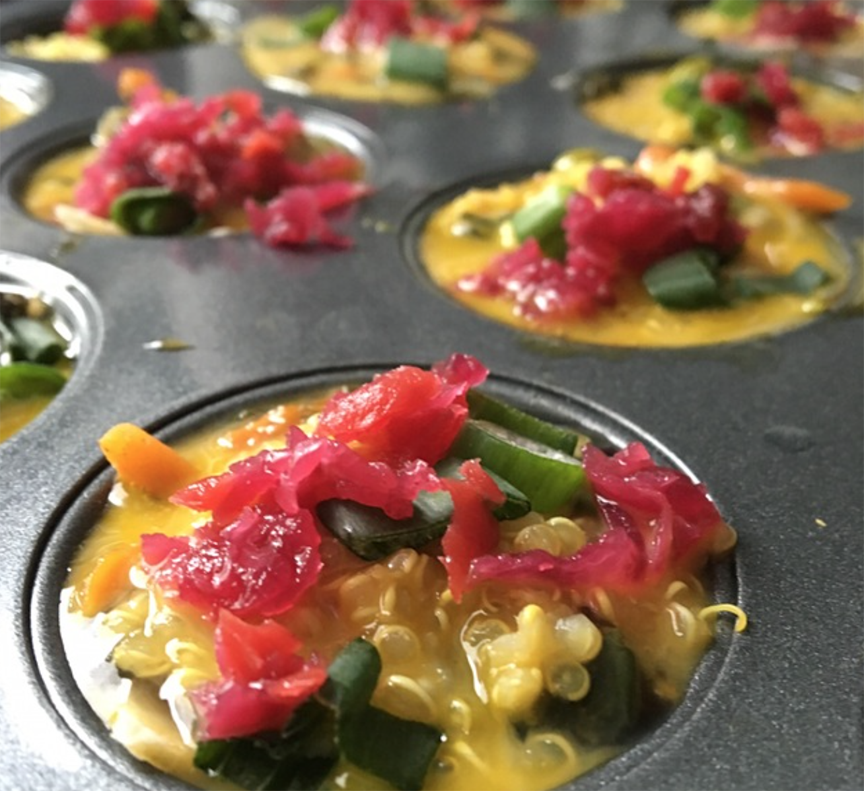
Breakfast: Frittata Muffins
Eggs are a good source of high-quality protein, and can be a key part of a balanced, no-added-sugar breakfast when combined with your favorite veggies. Bake them in muffin cups so you can grab one in the morning on your way out the door. They travel well, and can be eaten fresh out of the oven or cold out of the fridge.
Give your chopped veggies a quick stir fry (1 minute) while you whip up your eggs. Stir in the veggies, season with salt and pepper to taste, and pour into greased muffin cups. Bake on 400 until golden brown. Eat fresh, or store them in individual reusable containers in the fridge for a grab-and-go breakfast.
Avg Price: $2.00
Prep time: 3 minutes
Lunch: Protein Salad
Assembling salads can be time-consuming, but if you plan ahead with the right ingredients, you can put this together in a jiffy. Combine baby kale, lentil sprouts, sliced mushrooms, pumpkin seeds, chopped cauliflower, chopped cabbage, a couple of slivers of smoked salmon and a heaping spoon of hummus in a to-go container. Season with salt and pepper to taste. If your mushrooms, cauliflower, and cabbage are pre-chopped, you can assemble this in a matter of minutes. Adding hummus to your salad gives you extra fiber and protein, and acts as a dressing without wilting your salad during the day.
Avg Price: $3.60
Prep time: 3 minutes

Dinner: Slow Cooker Chicken Stew
Despite its name, the slow cooker is your best friend for speedy meals. Before you leave for work, toss your favorite veggies, grains, and protein in a slow cooker with water (or stock) and seasonings. Turn it on low, and by the time you get home, dinner will be ready! My favorite combination is lentils, chickpeas, tomato, organic chicken breast, farro, cauliflower, bell pepper, and garlic. Seasoned with salt, pepper, paprika, and fresh rosemary (which doesn’t wilt), or chili powder, cumin, cinnamon, cardamom, and coriander. On a cold winter night, this stew is filling, warm, and fully balanced for a nutritious meal.
Avg Price: $3.00
Prep time: 4 minutes

Bonus Snack: Sweet Potato Crisps
Thinly slice a sweet potato (with a knife or a peeler), toss in olive oil, salt, pepper, paprika, and rosemary, and bake for 2 hours at 250 degrees. Flip them once about halfway through the baking process. Snack on these instead of chips or french fries.
Avg Price: $1.00
Prep Time: 4 minutes
DAY 2
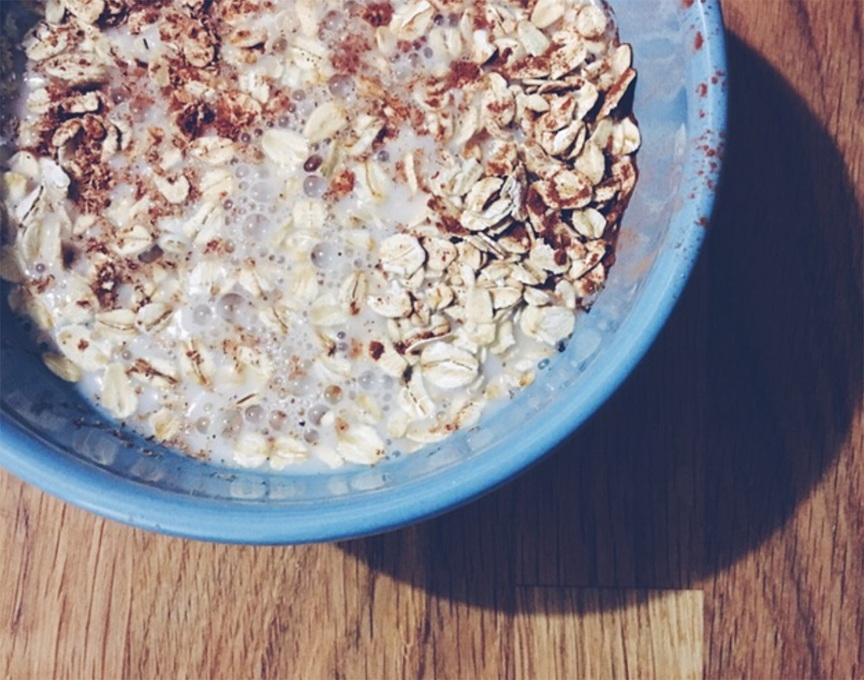
Breakfast: Overnight Oats in a Jar
The McDonald’s Dollar Menu has got nothing on this delicious, healthy breakfast. Jars give the ultimate convenience, but if you definitely need to discard your brekkie container, make it in a recyclable solo cup. Start with a base of plain rolled oats, then top with almond milk, nuts, cinnamon, and a drizzle of honey or coconut nectar for a bit of sweetness. By the next morning, you’ll have a DELICIOUS and filling breakfast that is ready to go when you are.
Avg Price: $1.17
Prep time: 2 minutes
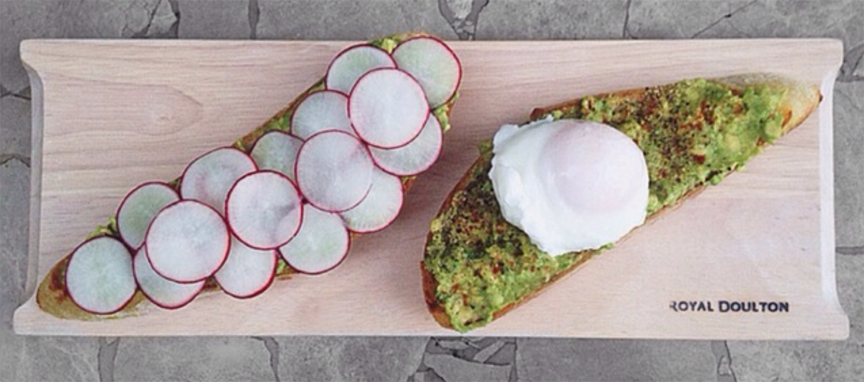
Lunch: Avo Egg Sandwich with Sprouts
Assembling a sandwich is one of the easiest things to do in the morning, but ensuring it holds up until lunchtime is the trick. This avo egg sandwich can be prepped in 5 minutes if you follow the right order of operations. First, heat oil in your egg pan. Put 2 slices sprouted whole grain bread in the toaster. Crack 2 eggs in the pan, season with salt and pepper, give it a quick stir, and turn the heat to low. Slice half of the avocado and sprinkle it with lemon juice. Grab the toast, flip the eggs, and slather one piece of toast with avocado. Once cooked, place the eggs on top of the avocado, top with sprouts, close your sandwich, and wrap it up. You’re done!
Avg Price: $2.20
Prep time: 4 minutes
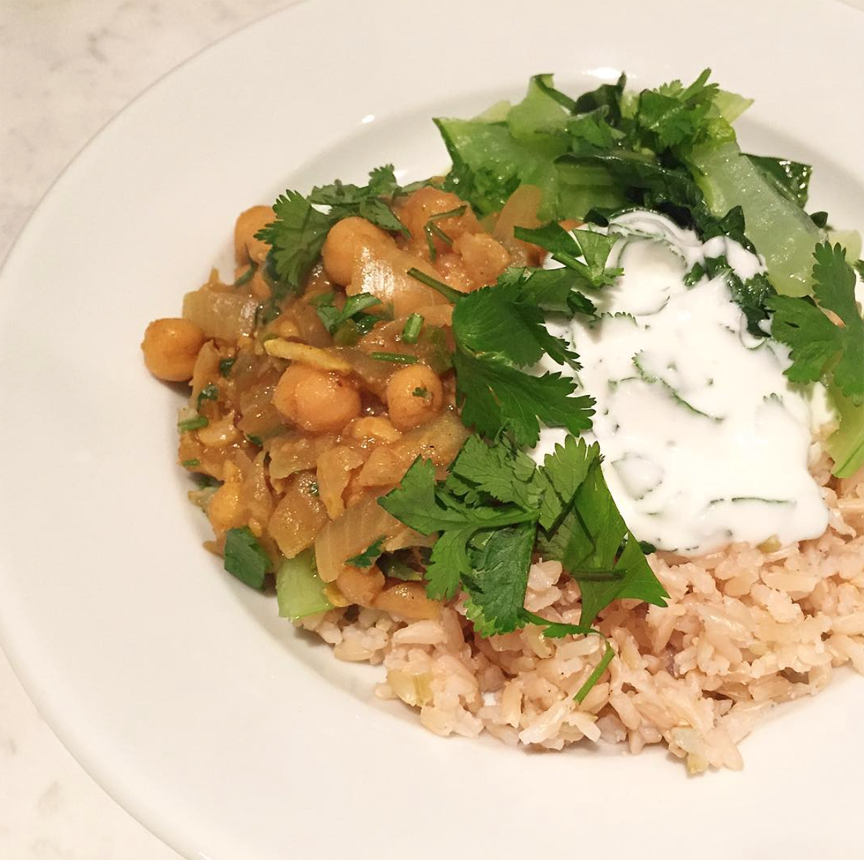
Dinner: Butternut Squash Chana Masala
Butternut squash is quite surprisingly affordable this time of year since it’s in season, and is a great source of carotenoids and vitamin A. The squash seeds can also be scraped out and toasted for a yummy snack (or most grocery stores sell pre-chopped squash, saving you a ton of time). Making chana masala is pretty simple—in a large saucepan, start with a base of tempered cumin seeds followed by sautéed onion, ginger, and green chili. Add in spices (coriander powder, cumin powder, red chili powder, and turmeric), toss in the squash, chickpeas, and tomatoes, season with salt and pepper to taste, and wait for it to cook. Top with lemon juice, and serve like a “stew” with a whole grain like quinoa, barley, or farro for a well-balanced, filling meal.
Avg Price: $3.39
Prep time: 4 minutes
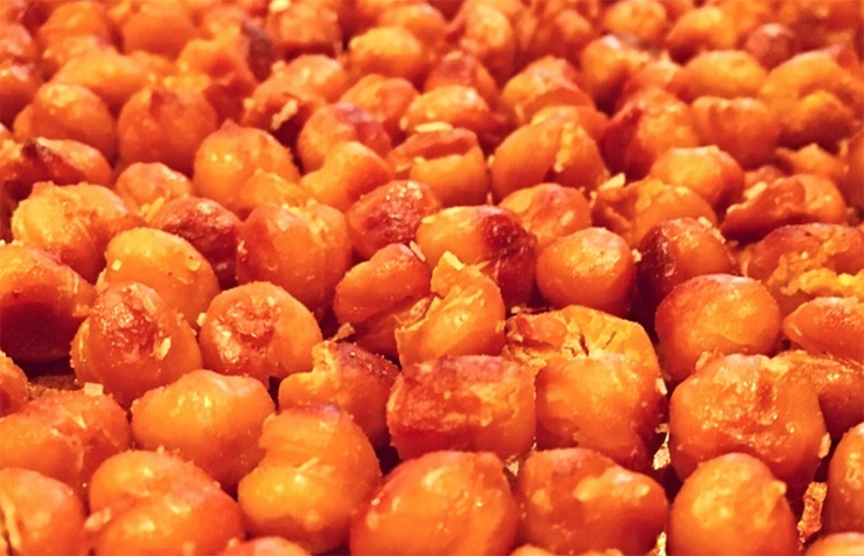
Bonus Snack: Roasted Crunchy Chickpeas
Rinse and pat dry canned chickpeas, toss in your favorite spices (our favorites include chili powder and curry powder or rosemary and lemon zest), salt and pepper to taste, and olive oil, and roast for 30 minutes at 450 degrees. There you have it—a delicious, crunchy snack for the week.
Avg Price $0.75
Prep time: 5 minutes
DAY 3
Breakfast: Sweet Potato Toasts with Almond Butter and Pumpkin Seeds
Swap sweet potato slices for your morning toast (they toast up in a toaster using the high setting for several cycles, or a total of about 15 minutes in a regular oven), and top with almond butter and pumpkin seeds—this is Mother Nature’s pop tart! You’ll get a healthy dose of fiber, protein, and hunger-fighting goodness with this hearty breakfast. If you’re on the go, sandwich two slices of sweet potato together and eat it on the run.
Avg Price: $1.15
Prep time: 4 minutes
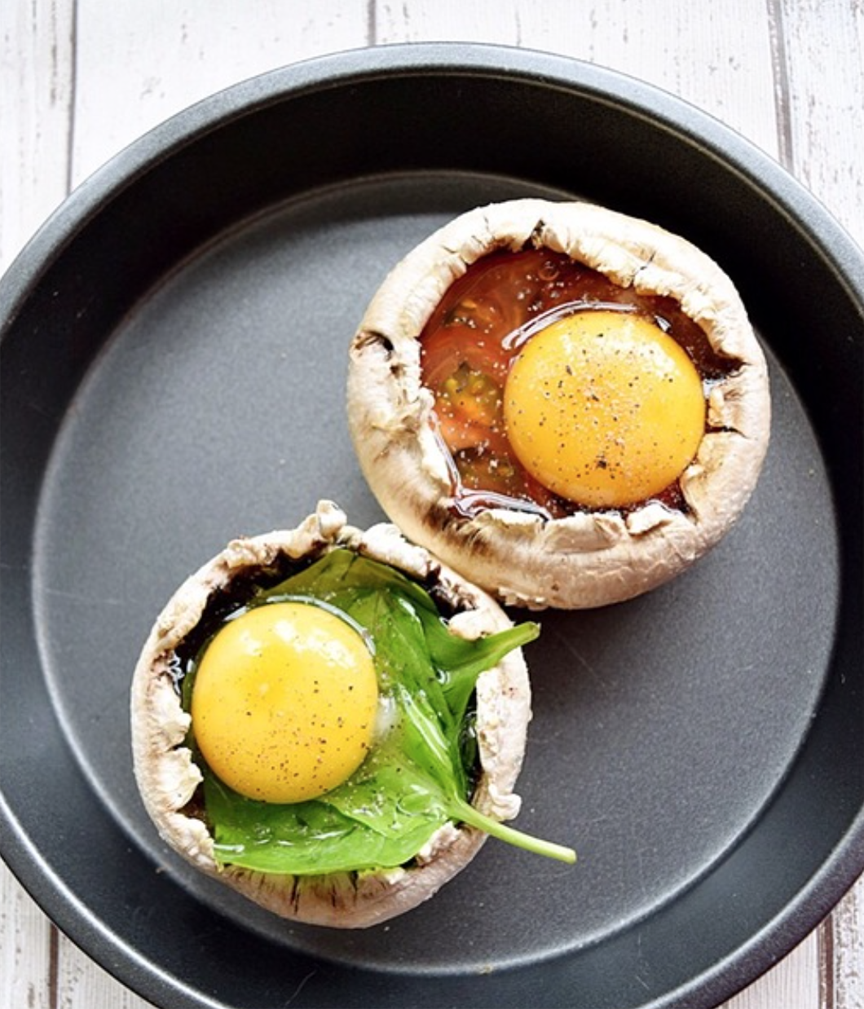
Lunch: Baked Eggs in Portobello Caps
Baked eggs are a perfect lunch to make before you head out the door in the morning. They take 2 minutes to prep, and bake to perfection while you’re getting ready. Lather two portobello mushroom caps in olive oil, sprinkle with salt and pepper, and place on a greased baking sheet. Crack 2 eggs in a bowl, whip, and stir in your favorite chopped veggies like broccoli, spinach, or thawed frozen edamame. Carefully pour half the egg and veggie mixture in each mushroom cap. Pop them in the oven at 375 degrees, and bake for about 25-30 minutes, until golden brown. Place them in a reusable container (preferably glass for easy reheating), and out the door you go!
Avg Price: $2.75
Prep time: 2 minutes
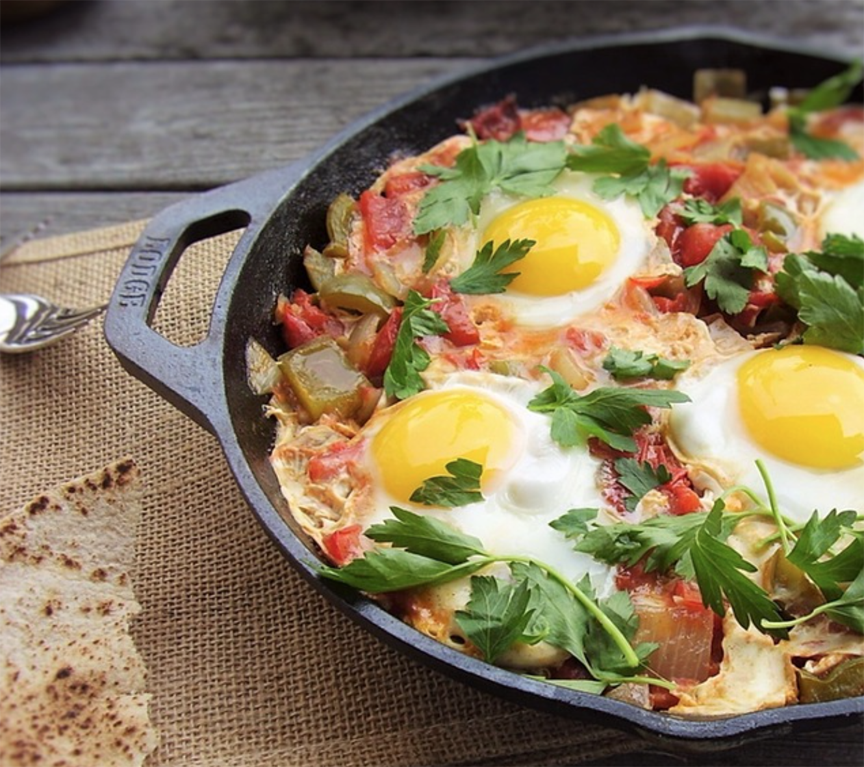
Dinner: Shakshuka
This Israeli brunch favorite can also be served as a one-pot dinner. You can customize it however you like by tossing in added veggies like broccoli or zucchini. This is also a perfect contender for chopped, frozen veggies to cut down on time. Start by sauteing onions and garlic in olive oil in a cast iron skillet. Add in a can of chopped tomatoes and veggies, and season with salt, pepper, paprika, chili flakes, and cumin. Let it simmer until tomatoes are mostly cooked. Make a few dents in the tomato sauce with a big spoon, and crack each egg directly into each dent in the sauce, leaving space between each. Cover, and let the eggs get poached in the stew and either finish on the stovetop or pop it in the oven for 2 minute bake. If you like, serve it with a slice of whole grain pita bread.
Avg Price: $4.25
Prep time: 5 minutes
Bonus Snack: Apples with Almond Butter
Apple slices with almond butter are easy to prep at home or at work (especially with an apple corer), and provide the perfectly sweet, juicy, and tart snack you’re looking for at 3pm.
Avg Price: $1.75
Prep time: 2 minutes
Now that you have a game plan, maximize your dollar and the clock by carving out a little time to chop your veggies on Sunday nights. Or if you’re in a serious pinch, start with frozen, pre-chopped veggies. Stock your pantry with nut butter, canned beans, and whole grains so you have some on hand. And keep nuts and seasonal fruits in sight so you have an easy snack always at your fingertips.












